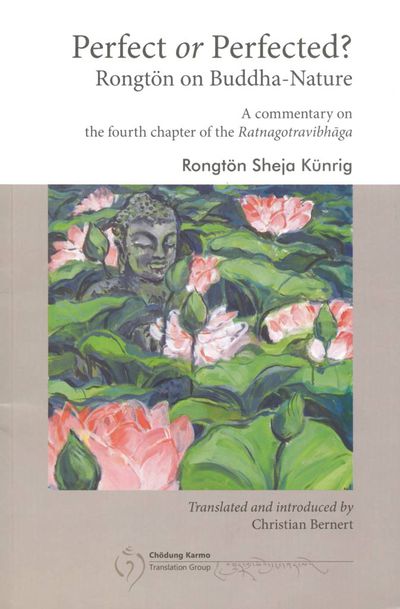Perfect or Perfected? Rongtön on Buddha-Nature
< Books
m (Saved using "Save and continue" button in form) |
|||
| Line 2: | Line 2: | ||
|BookParentPage=Research/Secondary Sources | |BookParentPage=Research/Secondary Sources | ||
|BookPerson={{Book-person | |BookPerson={{Book-person | ||
| + | |PersonPage=Rong ston shes bya kun rig | ||
|PersonName=Rongtön Sheja Kunrik | |PersonName=Rongtön Sheja Kunrik | ||
| − | |||
| − | |||
}}{{Book-person | }}{{Book-person | ||
| + | |PersonPage=Bernert, C. | ||
|PersonName=Christian Bernert | |PersonName=Christian Bernert | ||
| − | |||
| − | |||
}} | }} | ||
|FullTextRead=No | |FullTextRead=No | ||
| + | |BookEssay=This commentary is a key source for teaching buddha-nature and the Gyulama in the Sakya tradition and was authored by the famous Sakya master [[Rongtön Sheja Kunrik]]. The book is an updated version of Bernert's dissertation, which includes an annotated translation of Rongtön's commentary on the fourth chapter of the Gyulama (Ratnagotravibhāga) and an analysis of Rongtön's position, which is a useful starting point for understanding the view of buddha-nature teachings from a Sakya perspective. Rongtön's view of buddha-nature follows the analytical tradition of [[Rngog blo ldan shes rab|Ngok Loden Sherab]], but is somewhat complex and Bernert does a good job of presenting the complexities in his analysis. | ||
|BookToc=*Foreword vii | |BookToc=*Foreword vii | ||
*Preface and Acknowledgments ix | *Preface and Acknowledgments ix | ||
Revision as of 16:53, 14 August 2018
As the most important canonical treatise on Buddha-nature, the Ratnagotravibhaga (also known as Uttaratantrasastra, Tib. rgyud bla ma) established the doctrinal foundations for the Mahayana philosophy of tathāgatagarbha, the doctrine according to which all sentient beings are either inherently buddhas or endowed with the potential for awakening. Among the most prominent Tibetan commentaries on this text figures that of the Sakya master Rongtön Sheja Künrig, a prolific writer who was active during the golden age of Tibetan Buddhist philosophy. Refuting, on one hand, the notion that Buddha-nature is synonymous with mere emptiness, and on the other that the mind is inherently endowed with the Buddha qualities, Rongtön argues for an understanding of Buddha-nature that embraces both aspects of the nature of mind: cognizance and emptiness.
Rongtön Sheja Künrig (1376-1449) figures among the greatest teachers of the Sakya tradition. Particularly renowned for his commentaries on the Five Treatises of Maitreya, his vast erudition, and extensive teaching career made him one of the most influential masters for the scholastic lineages of all schools of Tibetan Buddhism. This volume contains an annotated translation of Rongtön Chenpo’s commentary on the central chapter of this treatise (including the relevant stanzas of the root text), along with an extensive introduction to the historical development of this doctrine and an analysis of Rongtön’s position. (Source: Vajra Publications)
| Citation | Bernert, Christian, trans. Perfect or Perfected? Rongtön on Buddha-Nature: A Commentary on the Fourth Chapter of the Ratnagotravibhāga (vv.1.27-95[a]). By Rongtön Sheja Künrig (rong ston shes bya kun rig). Kathmandu: Vajra Books, 2018. |
|---|---|

